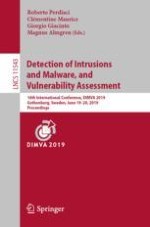2019 | OriginalPaper | Chapter
Large-Scale Analysis of Infrastructure-Leaking DNS Servers
Authors : Dennis Tatang, Carl Schneider, Thorsten Holz
Published in: Detection of Intrusions and Malware, and Vulnerability Assessment
Publisher: Springer International Publishing
Activate our intelligent search to find suitable subject content or patents.
Select sections of text to find matching patents with Artificial Intelligence. powered by
Select sections of text to find additional relevant content using AI-assisted search. powered by
